Koninklijke Marine 1939-45
 Koninklijke Marine 1919-1945, circa 120 ships.
Koninklijke Marine 1919-1945, circa 120 ships.
The Dutch Navy, with its long and glorious past, global commercial Empire and fleet in being, creator of the first multinational company, the VOC, was no longer a major player in WW1, nor in WW2, ranking just below the Spanish Navy. She counted five cruisers, four coastal defence ships, two training cruisers, five armoured gunboats and a modern sloop, 11 destroyers and 11 torpedo-boats, 30 submarines and a wide fleet of minelayers and minesweepers. This was still a far cry from the German Kriegsmarine, and more still, since the bulk of the navy was based in the East Indies (Java and Indonesia), the remnant and richest part of the Empire, facing an even more menacing Japanese Navy.
Introduction: The Dutch Navy Before WW1

Old Glories and remembrance: Willem Van de Velde victory over the British at Scheveningen on August, 10, 1657, part of the First Anglo-Dutch War.
Articles
- Admiralen class destroyers (1925)
- Dutch Submarines of WW2
- HNLMS De Ruyter (1935)
- Holland class cruisers (1895)
- Java class cruisers (1921)
- Tjerk Hiddes class Destroyers (1939)
- Tromp Class Cruisers (1937)
Holland class battecruisers (project)
Eendracht class cruisers (project)
Tjerk Hiddes class destroyers
Dutch gunboats
Dutch minelayers/minesweepers
The Koninklijke Marine was Created at the end of the Eighty Years’ War (1568–1648), taking independence from the House of Habsburg. She reached a peak during the Dutch Republic era (1581–1795), having at some point the world’s largest navy, which was pitted against England, France, and Spain’s own mighty fleets. During this golden age of great galleons and Indiamans, the Dutch Republic naval forces were spread among five separate admiralties (three in Holland, one in Friesland and Zeeland) operating local fleets, up to command organization, and revenues. The famous VOC (Dutch East India Company or Vereenigde Oostindische Compagnie) chartered in 1602 had its own fleets, armies, organization and command plus an international network of naval bases and colonies. This was the first modern global company, a state withing the state. The VOC was eventually closed when Napoleon’s armies conquered the Netherlands, after 200 years.
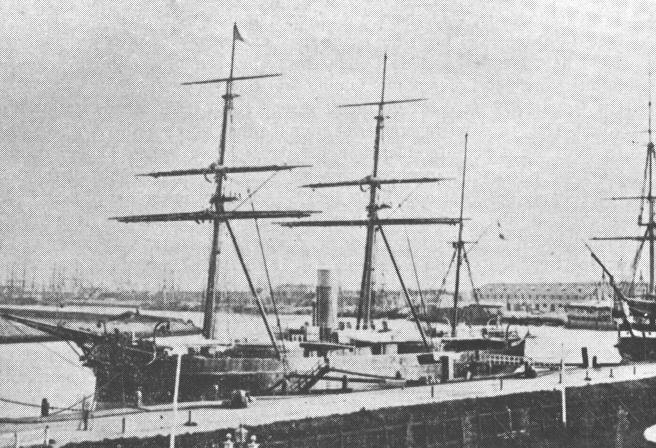
The XIXth Century was bleaker for the Dutch as a declined, which started from after 1713 and cluminated in the 1780. At this point, the Dutch Marine was no longer a match for the French and British navy, despite an ambitious revival in 1780, the fourth Anglo-Dutch War (1780-1784) was a catastrophe, the Dutch allowing free passage throughout the East Indies whole until 1789 what remained of the home squadrons were sent to the Dutch East India Company. Reforms with the academy and command structure occurred with the Batavian Revolution (1795) and a central organisation was funded in The Hague. However warships stayed in dry-docks, a few conveying William V to Great Britain and the others sailing to East Asia. In 1796 a squadron surrendered at Saldanha Bay (1796) while the lost Battle of Camperdown in 1797 followed by the surrender of the fleet near the Vlieter in 1799 erased what was left of the Batavian navy, now part of Imperial France. After regaining independence in December 1813, the Dutch navy revived but later in the 19th century suffered from constant shortage of manpower. In addition, the bankruptcy of the East India Company, against the bulk of the home fleet shifted to East Asia in 1850, with the “Government Navy”.
The navy began to modernize the fleet, introducing a series of monitors, two large turret ram ship (then ordered abroad). From 1867 however, the Rijkswerf in Amsterdam was the first shipyard modernized capable of delivering major warships. In the 1890s series of protected cruisers and coastal defense ships was introduced, with what became the Royal Netherlands Navy in 1905. The first submarines were introduced in 1910, and there were plans to order several dreadnought battleships in 1914.
The Dutch Navy in the Great War

In 1914, the Dutch fleet was in the same position as other Scandinavian fleets, having only one coast defense squadron to defend its shores and several obsolescent cruisers and torpedo boats. She was totally outclassed by the Hochseeflotte at home, while the bulk of her naval forces resided in the “pearl of the empire”, Indonesia, facing since 1905 the rise of Japan’s empire, confident after Tsushima. Achin’s war had, by its duration (1873-1904), considerably drained treasure, and naval budgets could only be modest. The metropolitan fleet could only waging a delaying action against the German navy, since the real peril came obviously from the land. On the Dutch East Indian Squadron, based at Java, the fleet could at least resist better to the Japanese until the concurrence of one or all the other allies, like nearby Great Britain. That was all theoretical as the Netherlands remained neutral. In addition by 1914 the British own Indian fleet had been withdrawn for the benefit of the home waters. The French navy of Indochina could only deploy minor units, while the Chinese fleet was inoperative, divided between local warlords, of dubious allegiance and value.
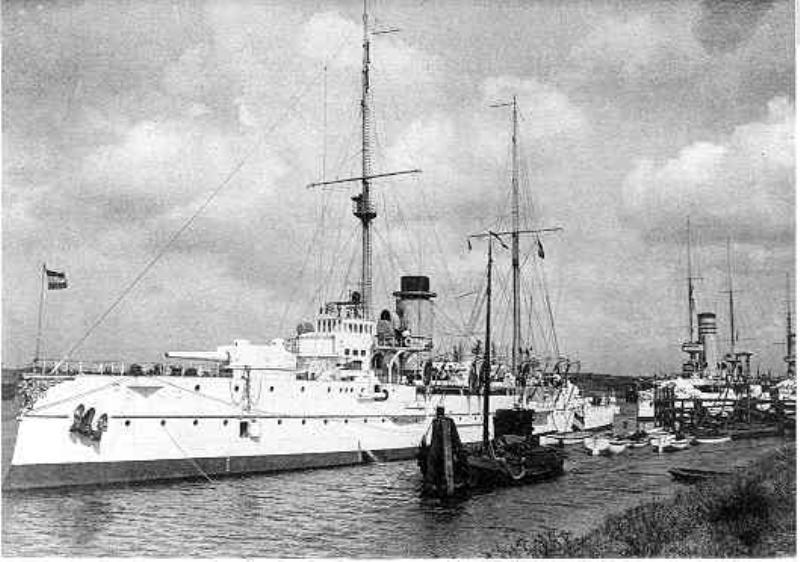
Therefore in 1908 at last, a vast rearmament plan was decided: Four coastal battleships of 7000 tons were ordered as well as submersibles and destroyers. The main focus was however on mine-laying capabilities in order to immobilize the adversary or channel it towards coastal artillery or strong torpedo forces.
A royal commission was appointed to study the question of defense of the East Indies, and recommended in 1913 the starting of 5 dreadnought battleships in the 20 000 tons range, as well as four for home waters as well as fifty destroyers, dozens of torpedo boats and large submersibles, as well as new minelayers. It was also planned to reinforce Batavia, transform it into a fully fledged fortified naval base with coal reserves and three forts own heavy artillery. With political opposition to this proposal, a crisis broke, and the plan was not voted on until August 1914. The outbreak of the war made it obsolete.
So here is the fleet strength on this date:
7 Coastal Battleships: De Zeven Provincien (1909), Kortenaer (1894-Evertsen class survivor), and five smaller Konigin Regentes (1900-06).
4 Cruisers: Classe Holland (1896-98).
8 Destroyers: Classe Fret (1910-13).
35 Topedo boats: 16 classe G (1904-14), 3 classe Draak (1906), 2 classe Ophir (1901), 5 classe Hydra (1900), Makjan, 4 classe Ardjoeno (1888). Seconde class XXI (1890) and 3 classe K (1905). 8 more in building.
6 Submersibles: O1 (1905), 4 class O2, and K1 (1913). Two more on order.
35 Misc.: 3 armoured gunboats Brinio class (1912), 2 minelayers Hydra class (1911), gunboat Borneo (1892), 2 Nias (1897), 3 Koetei (1898), 8 Hydra (1873-76), 16 Wodan (1877-79).
Tonnage 1914:
7 Coastal defence ships
4 Cruisers
8 Destroyers
6 Submersibles
35 TBs
35 Misc.
Operations of the Dutch fleet in WW1
The neutrality shown by Holland in 1914 was one of the most difficult to hold: The Second Reich armies were more than a match, both at sea and land and so were the Japanese, although themselves neutral then. The imposing Dutch maritime trade, especially with Germany and Great Britain was also a powerful obstacle to any engagement. With the blockade imposed later by the British Navy and severe control of merchant traffic, Dutch economic activity quickly weakened. In practice, the reception of German freighters was almost impossible, Batavian merchants committing themselves to it, and Great Britain kept the right to “blacklist” the offending importers, particularly on coal allocated to companies.
However, turnarounds were always possible, thanks in particular to the intermediary of Scandinavian countries. Thus Germany received millions of tons of Norwegian iron passing through Rotterdam. A large illegal food supply also developed with the black market inflating prices and creating many adventurers willing to take any risks. The Royal Navy however never hesitated to chase German blockade runners up in Dutch waters, less those passing through Batavian ports, not in principle worried.

In 1917, the Dutch were not spared the total submarine ware and lost 230,000 tons of trade shipping worth 147 million pounds sterling. New constructions in 1916 included two cruisers of the Java class, completed in 1925-26, 6 torpedo boats class Z, and submersibles O6, KII, class KIII, class KV, and class KVIII (completed after the war, in 1919-23), 2 trawlers and 5 tugboats converted to minelayers, 2 Van Meerlant class minelayers. In addition a German type UC and an English type H were recovered after sinking and reused by the Dutch navy, under the names of M1 and O8. Also in 1917, In 1917 the first airplanes were added to the navy. After the war the new light cruisers, destroyers and submarines were ordered and the inter-war renewal of the fleet started, although many ships re-ww1 were still in service when the war broke out in 1939.
The Dutch Navy in the Interwar
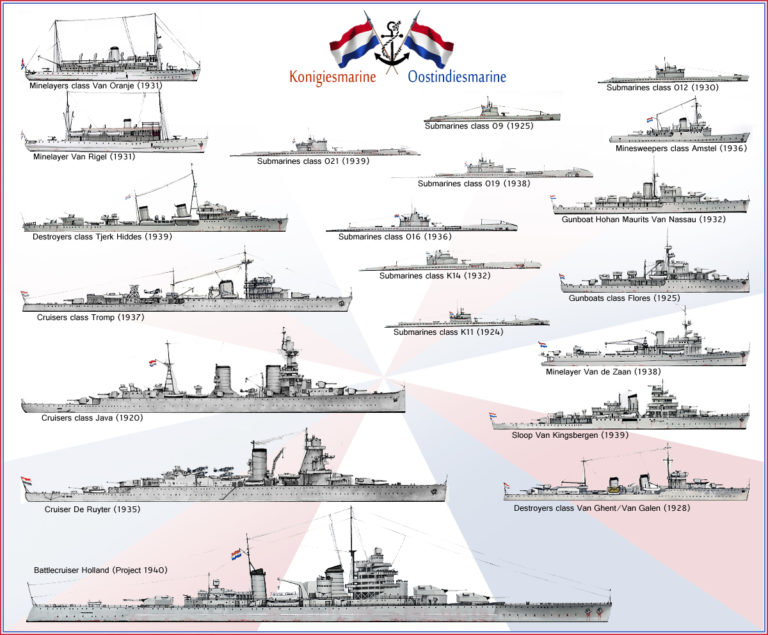
Overview of modern Dutch Navy ships in 1940 (Interwar ships, pre-ww1 ones are not depicted).
Early naval Plans 1920-1926
Home waters needed a reduced navy, as the most likely form of attack was to come from the land, and efforts were led to support a reduced fleet of minelayers, coastal TBs, and gunboats, and short-range submarines were added to the menu in the 1930s. Decision was made to built larger oceanic models for long range Atlantic patrols, and possible redeployment in the East Indies. However to mount new ambitious naval plans, the will was simply not there. After the wholesale cortege of destructions of the Great War, like in France and Belgium, there was a strong anti-war mood that plagued any budgetary initiative for years. In 1920 however a committee, well aware of the obsolescence of the fleet proposed four new cruisers, 24 destroyers and 32 submarines, most of which would be based in the East Indies. However without surprise, it was rejected. A more moderate plan for 12 destroyers and 16 submarines was against proposed in 1923 and rejected by the parliament. Ultimately in 1925 the construction of eight destroyers was at least authorized, in two batches FY1925 and FY1926.
About Dutch destroyers
Torpedoes:
According to this source these were all British models, from Whitehead, consistent with the design of early submarine models.
-250 mm model (Only Electric boat O 1)
-450 mm (17.7 in) all models up to 1925.
-530 mm (20.8 in) from 1924 (K XI and O 19)
-533 mm (21 in) O 12, K XIV, O 16, O 21.
Several topics needs to be discussed:
-Dutch destroyers in German service
-British destroyers in Dutch service
-Interwar Dutch destroyers
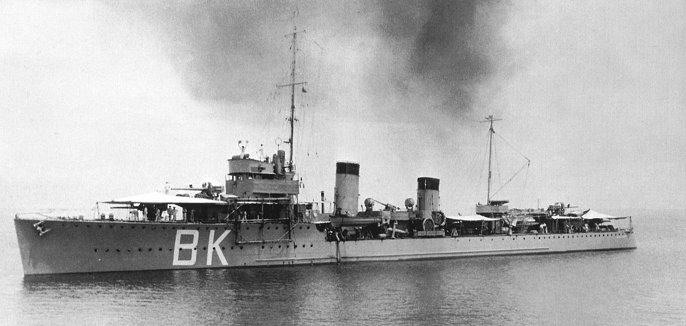
HNLMS Banckert
The destroyers of the old generation having been withdrawn from service in the twenties a new generation replaced them: The Van Ghent (4 ships, 1926), and Van Galen (4 ships, 1928-30) classes for the far east. The last four, Tjerk Hiddes class, were in completion during the invasion and only Isaac Swers managed to flee in Great Britain by her own means, completed at Chatham to British standards. The other three in construction were scuttled by explosive charge to avoid them being completed by the occupying Germans.
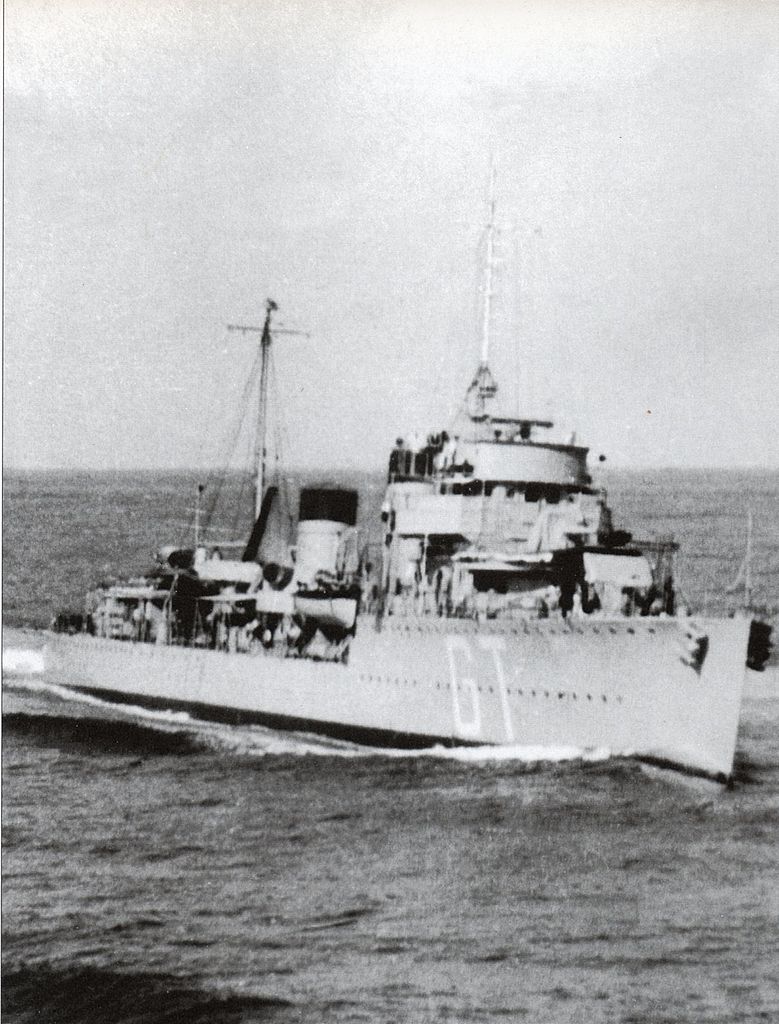
HNLMS Van Ghent
The Dutch East Indies defense plans
In the 1920s the collection of large and smaller islands that were part of the East Indies (now Indonesia, java, Sumatra, Sri Lanka…) were a major provider of raw materials, and most importantly, oil. The Dutch Colonies produced 20 million barrels a year (7th world rank), ten times the Dutch consumption. The most likely aggressor were the Japanese and local authorities were well aware of Japanese expansionism and naval strengths. However Holland had nothing near what was needed in its yearly budget to create a fleet to match. Decision was made in the end to concentrate all the efforts in a modern, quality navy that can delay enemy action long enough for allied reinforcements (from the commonwealth and US Navy, likely) to arrive, while harassing enemy supply lines. Naturally this tended to indicate a clear direction towards mine-layers and submarines. Cruisers and destroyers could still conduct major actions, in combination with aviation, and gunboats provide mobile coastal defence, while minefields were designed to channel enemy ships towards coastal batteries.
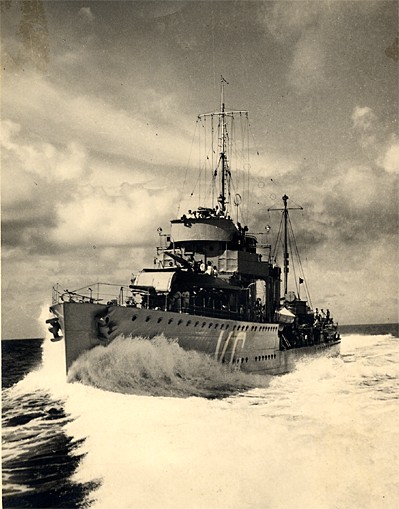
HNLMS Van Galen
In 1930 a committee submitted a plan asking for a strength of 3 cruisers, 12 destroyers and 18 submarines, in the East Indies. This led to the approval of the construction of a new cruiser (De Ruyter), 5 submarines (the KXIV). However new destroyers were rejected. With resounding boot noises from China in the late 1930s, a new rearmament plan was launched, however too late as the war started before most of these ships were completed. Of this very ambitious plan the crowning jewels were without doubt, the first Dutch “battlecruisers” (see later). The 1936 saw the construction of a modern, albeit small cruiser, Tromp, a new submarine, and three new cruisers from 1936, 4 destroyers and 9 submarines. Most were however scrapped. Only 1 cruiser, 1 destroyer and 6 submarines were eventually completed.
Organization of the Gouvernmentsmarine comprised multiple forces, the East Indies Squadron, with the bulk of the navy (cruisers, destroyers), and the East Indies Marine which included defence vessels like gunboats, minelayers, torped-boats, and submarines. Third, the East Indies Gouvernmentsmarine was own and run by the East Indies government, and merely counted coastal small ships and patrol boats, customs, survey etc, for local police duty and enforcing territorial waters integrity.
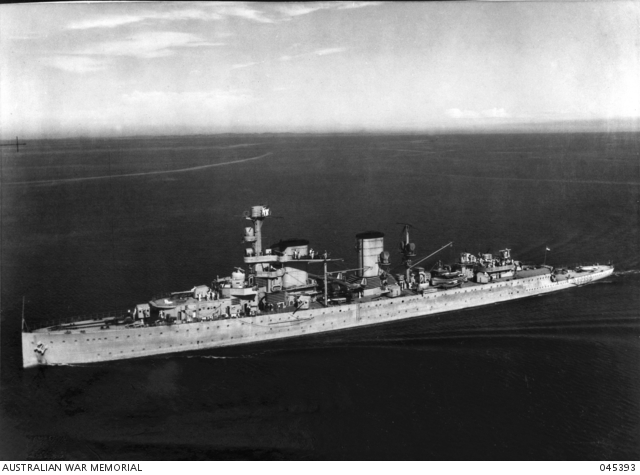
HNLMS Java in 1941.
Dutch Naval design
Since the beginning of the Century, Holland can count on quality shipyard and highly skilled manpower and reputed design bureaux. This autonomy was sufficient for most designs, but a few. For modern destroyers Holland turned to British expertise (Van Ghent class), and same for battlecruisers as they not possessed the industrial/design expertise for these patricular classes of ships. Classed among the “small navies”, Holland was nevertheless capable of delivery excellent ships by international standards. The De Ruyter in particular, which superficially resembled the German pocket battleships of the Deutschland class, is generally though of as a very successful design. Dutch destroyers were also of such quality that they even made the envy of the Royal Navy at some point. By sophistication and degree of equipment, these ships were again, above the standards of the era. The only deficient area was in terms of protection, knowing, however, that is was merely a matter of financial constraints and not of design limitations.
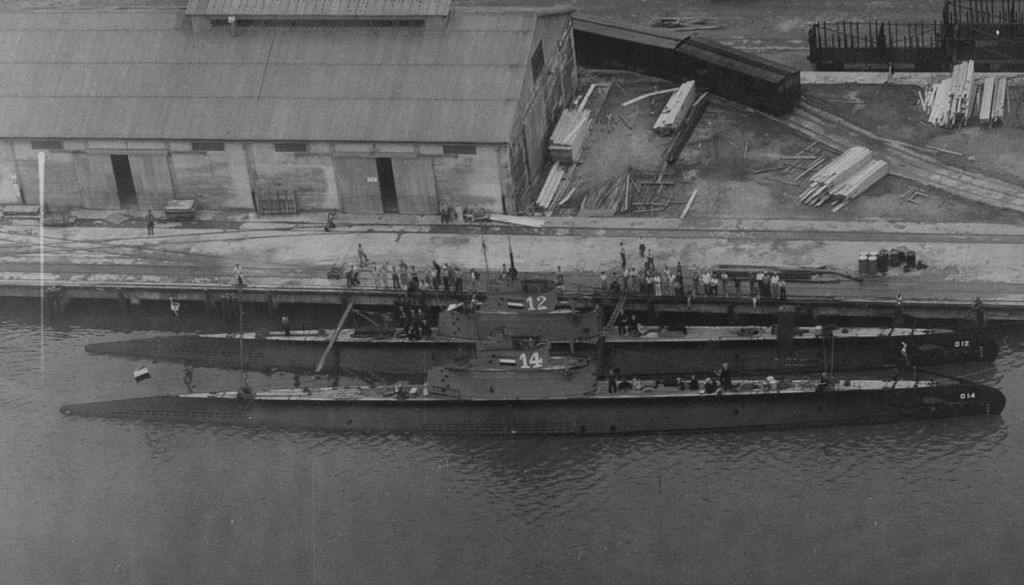
O12 and O14 at San Juan in 1937
The Dutch especially excelled in fire control and gunnery gears, introducing 3-axis stabilization (a rare feat in the 1930s), remote control and general automatization at multiple levels. AA artillery was also excellent, with the twin 40mm Hazemayer mountings that were ahead of their time and made their way on British ships later, generalized with radar. It is also seldom known that the Dutch were among the first to introduce a workable Snorkel, was quickly adopted by the Germans and installed in standard on their brand new U-boats. The hague also housed an important German shipyard in disguise for export submarines, and crossed engineering happened.
Dutch Naval order of Battle
cruisers:
Two old Holland class cruisers remained in service (1899), the Gelderland as a training ship of the gunners, and the Noordbranbant as a ship-depot. At their side were also the two much more recent ships of the Java class (1920-21), Java and Sumatra. Before the arrival of HLMNS De Ruyter, they formed the backbone of the Dutch fleet. But the decisive step will be taken with the start at Wilton-Fijenord, the large arsenal of the fleet, of the cruiser De Ruyter. Launched in 1935, she took the place of the cruiser HLMNS Celebes of the Java class canceled in 1919. She was a light cruiser by tonnage, and armament (7 x 150 mm, distributed in double turrets and a single.).
In 1937, in continuation of this plan, the HLMNS Tromp was launched, in 1939, a sister ship, HLMNS Jacob Van Heemskerck. At the time of the German invasion, she was able to sail to Portsmouth for completion. Too small to serve in the east Indies, both will fight with the Royal Navy, under Batavian flag and with a crew of the United Provinces. The last two cruisers, much heavier than the De Ruyter, were those of the De Zeven Provincien class. They were in full construction when the Germans arrived. The HLMNS Eendracht, sister-ship of the Provincien, was spared during the bombing of Rotterdam, and the construction of these two ships resumed well after the conflict after many modifications, before having a second, long life under Peruvian flag.

HNLMS Banckert
Destroyers:
The buildings of the old generation having been withdrawn from the service in the years 20, it was those of the class Van Ghent (4 ships, 1926), then Van Galen (4 ships, 1928-30) which replaced them, sent in extreme -Orient.When the last four, the Tjerk Hiddes, they were in completion during the invasion, and only the Isaac Swers managed to flee in Britain by his own means. He was finished at the standards of the Royal Navy, the other three being scuttled.
Torpedo boats:
The Batavian navy could still count on six ships of this type (1912-19) for its close defense, the other five being based in Soerabaya.
Submersibles:
Among the oldest, there were the O8 (former British 1916), the XVII of the class XV, and the three of the class XVIII. They had three first successors, the KXI (1924), then the five K XIV; The three O9 (1925) and the four O12 (1930) and the O16 (1936), smaller. The two O19s launched in 1938-39 were of the minelayers type. the last series, the O21s built in Rotterdam and Fijenoord were victims of the invasion. The first four, advanced enough, escaped to Great Britain and the other three were captured and integrated into the Kriegsmarine in 1941-42.
Gunboats:
A large part of the Dutch East Indies was guarded by powerful gunboats. The oldest were the three armored Frisos (1912), relegated to the metropolis, while the Colonies relied on both Flores (1925), Johan Maurits Van Nassau (1932), and Van Kingsbergan (1939), which was used in France after his flight to Britain. three others were under construction, but were completed by the Germans in 1942.
Minelayers:
Another important part of the Batavian defense system in the Far East, minelayers were quite numerous. There were ships of the Hydra class (1911), Douwes Aukes (1920), Pro patria (1922), Krakatau (1924), Nautilus (1929), Rigel (1931), both Van Oranje ( 1931), Jan Van Brakel (1936), Willem Van de Zaan (1938) and two Ram (1941) built locally, the first of which was scuttled and the second served in the Japanese Navy. There was also the 8 Jan Van Amstel (1936-37), an unfinished ninth being recovered and reused by the Germans.
There were also 40 coastal minesweepers, very small vessels armed mostly with two machine guns, of different types (see following list).
Finally, the 1st prize for longevity contest could be awarded to the 10 ships of the Woden class, former gunboats dating back from the 1870s!
Miscellaneous:
There were also gunboats, patrol boats of civil origin some armed with old guns of various stocks, capable of operating an infantry company but slow and poorly armed, but able to navigate rivers of Dutch Indies. These were Folmalhout and Merel, ships of the Sirius, Arend and Fazant classes, dating back to before 1930. At their side were four motor torpedo launches built by Thornycroft and one at Surabaya.
There were also 4 minesweepers of 1916 M1 class, and three coastal defense vessels, the Vlieereede ex-Hertog Hendrik (1902), the Ijmaiden ex-Van Heermserck and the Soerebaya ex-Zeven provincien.
Tonnage 1939:
Ships of line 0, Cruisers 4, Destroyers 8, Torpedo-boats 11, Submarines 22, Miscellaneous 107
The Dutch Navy in WW2
During World War two, the Dutch navy was forced to flee due to the fall of the country in May 1940 sailing to Allied countries, and quickly had its new wartime headquarters placed in London. Still at that time, the majority of the fleet was in the East Indies, so smaller offices were established in Sri Lanka and Australia. There, Dutch ships took part in troop transport for the allies, and some also in home waters (Operation Dynamo) and again in 1944 during D-Day. Reinforced with British-stock ships they took part in the escort of numerous convoys and attacks. The heaviest losses were suffered in the desperate defence of the East Indies against the Japanese. The Battle of the Java Sea in February 1942 saw the rear admiral Karel Doorman going down with most of his ships, 2,300 of his crew, and the provisional ABDA fleet (counting also British and Australian ships), under command of Doorman, ceased to exist and with it hopes of further resistance.
Fate of the Dutch Home Fleet
On 10 May 1940, the Wehrmacht, assisted by the Luftwaffe, steamrolled the small Dutch Army, which resisted by five days until being submerged. Despite skeletal tank forces (a few armoured cars) and limited antitank guns, the infantry put at some place a very sturdy defence, in particular at the Hague against German paratroopers, Kornwerderzand (which only capitulated after the surrender was made official) and in front of Rotterdam. of course, the Navy made preparations for departing and not falling uselessly in the hands of the Germans. Present forces counted two cruisers, 1 destroyer and 9 submarines, 2 gunboats, 1 sloop and 6 torpedo boats. Most departed for UK but some were also destroyer by the Luftwaffe or sabotaged and scuttled, with a few captured. From May, 20 onwards, the new Dutch government in exile was established in London, and the navy followed. Surviving ships in British waters were placed under the authority of the Royal Navy. They will be reinforced by new ships (and new volunteers from the continent) and served with distinction in many operations until the end of the war. It is seldom known that at some point, the Dutch operated three merchant aircraft carriers (Nairana, Colossus and Gadila) in Atlantic escort duties.
These modest forces will be drowned in the mass of operations in the Atlantic or Murmansk, near the Arctic Circle, as the Poles or the FNFL, but will assume their role until the Nippon capitulation, especially in the convoy escort, including in areas where it was not expected as in the Mediterranean: The Isaac Swers destroyers will be sunk in front of Algiers in November 1942. The latter took part elsewhere in fierce destroyer fightings.
Transfers and completions: The continuation of the struggle (1941-45)
As we have seen, units that were not scuttled or captured had time to take refuge in Great Britain, including those that were not completed: Thus, the cruiser Van Heemskerck, the destroyer Isaac Swers, the submersibles O21 to 24 continued the fight in the hands of free Batavian sailors. Many of thse caused supply problems because of their non-standard equipment with the Allies, and some were laid up or scrapped.
On the other hand, Holland received the following lease-leases: First of all, two British class N destroyers, renamed Van Galen and Tjerk Hiddes, a corvette of the Flower class, the ex-Carnation Friso and the River type Van Nassau class ex-Ribble, the Queen Whilemina ex-PC468 sub-chaser. British Admiralty MMS coastal minesweepers will also be transferred, 18 vessels, also 6 US Vosper type motor torpedo boats (Tm22-37, but 11 in fact), and other British type White and Vosper leased from 1942 (11). But above all, Holland operated from 1943 two oil tankers escort aircraft, the Gadila and Macoma.
Units transferred or received between 1940 and 1945: 1 Cruiser, 3 Destroyers, 2 Submersibles, 22 MTBs, and 24 Misc.
In 1945-46 the Dutch acquired many more ships to replace those returned after the war: The escort carrier Karel Doorman (ex-Nairana), destroyer Evertsen (ex-Scourge), Kortenaer (ex-Scorpion), Banckert (ex Quillian), minesweepers Ambon, Banda, Batjan, Boeroe, Ceram, Moratai, Ternate, and Tidore. Fot further information see the coldwar Dutch navy page.
War in the East Indies
Pitted against the world’s third largest naval power, the forces of the Empire of Japan, prospects were bleak. War was declared from 7 December 1941, acted on December 8 (and Italy on December 11). The local Governmentsmarine’s East Indies Squadron then counted a sizable force of four cruisers, seven destroyers, backed by fifteen submarines. Operations began swiftly, but losses started also the first month, with the loss of four submarines. The invasion of the East Indies started on January, 11, 1942, the Japanese landing in the Celebes as an advanced base for future operations. Objectives were of course the rich oil supplies, which could guarantee operations of the IJN throughout the southern pacific for years to come.
In the Far East, other ships were being completed but scuttled or captured in the course of 1942. The Japanese completed their service. For example, of the many coastal minesweepers, only Type A, Merbaboe, Alor, Ardjoeno and MvI (25 vessels) were in service, with the Merapi and Djember (12 vessels) bolseting the Japanese Navy here. Torpedoboats were also in service in 1942, the Tm4 to 21, whose Tm16 to 21 were unfinished: All will be scuttled or sabotaged in March 1942 in Soerabaya. Tm51 to 61 were built in Gusto, Holland, but all but two were captured and returned to service under the German flag.

Batte of the java sea in February 1942, the end of the Dutch East Indies Squadron
The Japanese steamroller then took Borneo, Amboina, Sumatra, Bali, Timor, and finally Java until the end of March. There were fierce fighting on land still, as the Dutch at least possessed many tanks contrary to the mainland. Ranging from light Vickers types to American Marmon-Herringtons of various models. Meanwhile at sea, the allies were hard-pressed themselves and could not provide the awaited support. They only sent a token reinforcement of British, US and Australian units to the East Indies squadron. The composite ABDA force was ill-prepared and organized and could do little to prevent the Japanese to succeed in the battle of the Java sea. In one swoop, and the the following weeks, the whole squadron was annihilated, and the remainder of the ships were scuttled lost or captured, except the destroyer Sumatra, that fled to Australia, gunboat Soemba and seven submarines. They all passed under Royal Navy control under the end of the war.
The Dutch Navy in detail
Holland class battlecruisers (1940)

There was no Dreadnought or even older battleships in service, but small and old battleships, closer to the Scandinavian coastal battleships. They will be seen in another topic. Between 1920 and 1938, the Dutch Navy was deprived of this type of ship for the lack of budget. It was not until 1938, that a new plan included the proposal to build three battlecruisers (actually rather fast battleships), approved by the parliament, by then aware of the rise of the IJN and especially recent bellicist demonstrations. Despite their enormous cost, these ships were studied in a very short time, also planned to be equipped with the same turrets ordered in the Third Reich, triple 280 mm model already used by the Graf Spee and Scharnhorst, which would have outclassed any Japanese cruiser. There was no question of opposing Japanese battleships, the task was to be left to an alliance with UK and the might of the Royal Navy in nearby Singapore.
After final blueprints had been drawn, they were approved in February 1940. By May, however, construction had not started. They had no official name, and the reconstruction (according to the Nyd blueprints archives) shows them as they were to be after their prospected completion in 1944. HLMNS Holland would have been launched in 1943, and completed en 1944 as well as the Gelderland and Noordbrabant.
Specifications
Dimensions: 237 x 30 m
Displacement 28 000 tonnes standard, 34 000 FL
4 shafts, turbines, 8 Werkspoor boilers, 180 000 cv= 33 knots
Armour 225-250 mm max
Armament 9×280, 12×120, 14×40, 8×20 mm AA.
Crew 1050.
Cruiser De Ruyter (1935)

De Ruyter in her original livery, 1938. HD
De Ruyter was ordered in 1930 to replace the cancellation of the third unit of the Java class in 1919. The Dutch Indies squadron had to have at least two cruisers in permanent operations. Due to severe budgetary restrictions, her design was finalized with only 6 x 150 mm, instead of the initially planned 8 x 150 or 6 x 203 mm, and a very light protection. With 6,000 standard tonnes she was in effect classed among the light cruisers. The second version was larger, with additional space for a simple 150 mm gun, and extra space for the oil storage and a more capable propulsion. The De Ruyter had 40 mm double Hazemeyer mounts placed on the rear superstructure, and double machine gun mounts spread on the flanks in four positions.
In appearance, she was very much inspired by the German pocket “battleships” of the Deutschland class. Launched in 1935, completed in 1936 and deployed in Indonesia with two Fokker CX 1W reconnaissance seaplanes, she participated in the defeat of the local fleet against the IJN during the invasion of Java, and with the ABDA squadron, as a flagship. Karel Doorman raised his colors on ths ship, which took part in the Battle of the Java Sea on February 28, 1942 and fought a Japanese line of heavy cruisers. She was hit by 203 mm shells from the Haguro, and finished off by a torpedo attack, which was fatal. She will sink two hours later with much of her crew.
Specifications
Displacement & Dimensions 6000t, 7550t FL 170.80 x 15.70 x 5.1m
Propulsion 2 propellers, 2 Parsons turbines, 6 Yarrow boilers, 66,000 hp. and 32 nodes max.
Shield, deck30, turrets 30 mm, belt 50 mm, casemate 30 mm
Crew 435
Armament 7 x 150 mm, 10 x 40 mm AA, 8 x 12.7 mm AA MGs, 2 aircraft.
Java class cruisers (1921)

HLMNS Java shortly before the battle of the same name in February 1942.
The three cruisers of the Java class were started in 1916-17 to replace older units in the Dutch Navy squadron. The class counted the Java, Sumatra and Celebes, but the construction was delayed and finally HDLMS Celebes was abandoned in 1919, construction focusing on the remaining two, which were completed in 1923, entering into service in 1924. They were already of an obsolete design with their artillery arrangement in 10 single 6 in mounts (150 mm), and were equipped with Fairey IIID seaplanes.
In 1934-35 they were both modernized at home, fitted with a modern fire system with a new armored tower on the German model. 8 and 6 x 40 mm AA Bofors replaced the old “13 pounders”. During the war, HDMS Java faced the Japanese after the loss of De Ruyter and ABDA squadron, being sunk in February 28, 1942 by Haguro and Nachi. Sumatra, refuged in France, fled to Britain and was scuttled to create an artificial breakwater on June 9, 1944 during the Normandy landings, to facilitates the following amphibious operations and the building of the Mullberries later.
Specifications
Displacement & Dimensions 4000t, 5850t FL 156 x 14.20 x 4.9m
Propulsion 2 propellers, 2 Parsons turbines, 6 Yarrow boilers, 46,000 hp. and 30 nodes max.
Armour deck crew 30, turrets 30 mm, belt 50 mm, casemate 30 mm
Crew 435
Armament 10 x 150 mm, 8 x 40 mm AA, 8 x 12.7 mm AA MGs, 1 airplane.
Tromp class cruisers (1937)

Martin Hapertszoon Tromp in 1940.
These two scout cruisers were originally designed to lead groups of destroyers. They had 6-in guns in three twin turrets protected by almost integral shields, a catapult-free seaplane and four 40 mm AA Hazemeyer guns. During the invasion of May 10, 1940, the second ship, HDMS Jacob Van Heemskerck, was in the process of completion, but lacked rangefinders and main armament. The two made it to Great Britain, and the second was completed on the standard of British light cruisers. In 1942, she emerged at last with a tripod mast, new rangefinders, radars, five 102 mm twin turrets, a quadruple 40 mm Bofors mount (and later four Hazemeyer batteries), and six 20 mm AA Oerlikon guns. At the same time, HDMS Tromp also received radar and additional AA with six 20mm and four 76mm AA rapid fire guns. Both ships were employed extensively within the Royal Navy until 1945. They were retired from service only in 1958.
Specifications
Displacement & Dimensions 3787t, 4800t PC_132 x 12.40 x 4.2m
Propulsion 2 propellers, 2 Parsons turbines, 4 Yarrow boilers, 56,000 hp. and 33.5 knots max.
Armour deck 25, turrets 15 mm, belt 15 mm, bunker 30 mm_Equipage 309
Armament 6 x 150 mm, 8 x 40 mm, 4 x 12.7 mm AA MGs, 6 x 533 mm TTs, 1 aircraft.
Destroyers classe Van Ghent/Van Galen (1926)

Kortenaer in 1941
In order to assist squadron cruisers of the Far East, two squadrons of eight destroyers were voted by the parliament and built between 1925 and 1930 in the Burgehouts, Fijenoord and De Schelde shipyards. They were very inspired by the HMS Ambuscade, the new British standard. The Van Galens were identical to the Van Ghent, except that the former had a battery of machine guns and rails to lay down 40 mines, and the second Hazemeyer 40 mm AA mounts in place but minelaying equipment. The last two, Piet Hein and Van Ghent also had a seaplane in place of their rear torpedo bank and no shields on their upper superfiring guns.
The Van Galen was the only present in France in May 1940. She was sunk by the Luftwaffe in Rotterdam, and later refloated by the Germans for demolition. The other seven were stationed in Java when the Japanese attacked in early 1942. The Van Ghent was damaged in the Bangka Strait, she ran aground and was abandoned by her crew. The Piet Hein was sunk in a duel with the destroyers Asashio and Oshio, the Kortenaer was torpedoed and sunk during the Battle of Java and the Evertsen, pounded by cruisers and literally razed, ran aground and was abandoned on a beach during the furious fighting of February 1942. The Van Nes suffered the same fate in Bangka Strait, Witte de With and Banckert were damaged by a Japanese air raid in the Sorebaya base, the first being scuttled and permanently lost, the second captured by the Japanese and repaired, under the name of patrol boat No. 106, but she was never operational and was discarded in 1945. She was the only one to survive the conflict, but the Dutch destroyed her as a target in 1949.
Specifications
Displacement & Dimensions 1316t, 1650t FL 98,15 x 9,53 x 2,97 m
Propulsion 2 shafts, 2 turbines Parsons, 3 Yarrow boilers= 31 000 hp, 36 knots.
Crew 120
Armament 4 x 120 mm, 1 x 75 mm, 4 x 40 mm AA, 4 x 12,7 mm AA MGs, 6 x 533 mm TTs.
Destroyers class Tjerk Hiddes (1939)

Isaac Swers shortly after delivery, before being camouflaged in May 1941
The naval plan of 1938 envisaged the construction of four new destroyers, ten years after the Van Galen class. Again, the inspiration was a British design, but this time better suited to Japanese destroyers. So these units were larger, faster and had a reinforced armament, including two twin turrets (forward and aft) 5-in/120 mm and a single at the rear. The torpedo tubes banks were quadruple, and the AA artillery included four 40 mm Bofors Hazemeyer guns. They also carried a floatplane, stored between the two funnels, without catapult.
However, these four ships were undertaken too late, and in November 1939, the first two were launched, but not completed during the invasion of May 1940. The third, Isaac Swers, was launched in March 1940, but was so far from being completed in May. To avoid capture, and despite the danger, she was towed away, disarmed, to Great Britain. The last, Philips van Halmonde, was not launched but broken up in situ. The first two, Callenburgh and Tjerk Hiddes, were scuttled in the harbor, refloated by the Germans. Only one was completely repaired, the Callenburgh, which resumed service in the Kriegsmarine under the name of ZH1. She will be sunk on 9 June 1944 by two British destroyers when trying to oppose the landings. As for the Isaac Swers, she was completed in a British yard with local equipment (6 x 102 mm guns in twin turrets, 4 40 mm guns and two 12.7 mm quadruple mounts) and was accepted for Dutch service in May 1941. She served in the Mediterranean, sinking an Italian destroyer with the help of other units. She was torpedoed during Operation Torch by the U431 in November 1942 while supporting troops in front of Algiers.
Specifications
Displacement & Dimensions 1604t, 2230t PC_107 x 10.60 x 2.80 m
Propulsion 2 propellers, 2 Parsons turbines, 3 Yarrow boilers, 45,000 hp. and 37.5 knots max.
Crew 158
Armament 7 x 120 mm, 4 x 40 mm cannon AA, 4 x 12.7 mm AA MGs, 8 x 533 mm TTs, 24 mines.
Class K XI Submersibles (1924)

These units were derived directly from the KVIII of 1922. They were larger and better armed, able, thanks to the strengthening of their hull, to dive deeper (60 meters). Like all “K’s”, they were meant to serve in the far Asia squadron. For this purpose, their tubes had a recharge torpedo each, 12 in total, and their trade warfare 450 mm torpedo tubes were distributed front and rear, the 533 were placed in the bow only. Their autonomy of 3500 nautical miles was important. As always, this was a class of three units. The KXII was sunk by Japanese planes in the harbor of Soerabaya in February 1942, and the other two managed to take refuge in Australia, carrying out few missions until 1944, when they were disarmed.
Specifications
Displacement & Dimensions 670T. surface, 815t Diving 67 x 6,15 x 3,70 m
Propulsion 2 propellers, 2 diesel-electric MAN, 2400/725 hp. and 15/8 knots surf./dive ..
Crew 31
Armament 2 x 533 mm TTs, 3 x 450 mm TTs, 1 x 88 mm, 1 x 12.7 mm AA MGs.
classe K XIV Submersibles (1932)

Designed to succeed the K XI of 1924 in the East Indies, this new series included this time 5 units. They were bigger, faster and integrated a bank of surface traverse additional tubes on the French model. Their eight tubes were four in the bow, two in the stern and two in front of the kiosk in this moving bank, with 16 torpedoes carried in all. On a technical level, they relied instead on the O12 class coastal units. They could dive to 80 meters and had the same autonomy of 3500 nautical at 8 knots on the surface.
When Japan attacked, these units multiplied missions, the K XVI managing to torpedo and sink the destroyer Asagiri December 24, 1941. But the next day she succumbed under the torpedoes of I-66. The day before, the 24th, the KXVII and the K XVIII will be sunk, the first by destroyer gunfire and the second by Deep-charges. But she managed to join Soerabaya, aonly to be scuttled here. The Japanese refloated her for later use as a radar picket and she was torpedoed again by British submarine HMS Taciturn in 1945. The K XIV and K XV managed to flee to Australia, and from where they continued their offensives against the Japanese merchant traffic until the end of the war. They will be disarmed in 1946.
Specifications
Displacement & Dimensions 771t. surface, 1008t Diving 74 x 7.60 x 3.90 m
Propulsion 2 propellers, 2 diesels-electric MAN, 3200/1000 cv. and 17/9 knots surf./dive ..
Crew 38
Armament 8 x 533 mm TT, 1 x 88 mm, 2 x 40 mm AA.

O9 class Submersibles (1925)

The “O” are coastal and designed to defend the metropolis. They have 2 tubes of 530 mm in bow, 2 others of 450 mm, and one in stern, with 10 torpedoes on board.
At the time of the German invasion, the O11 was scuttled while the first two joined England to continue to serve with the RN by tracking the U-Bootes. They will be demolished in 1945.
Specifications
Displacement & Dimensions 515T. surface, 647t Diving 54.70 x 5.70 x 2.50 m
Propulsion 2 propellers, 2 MAN electric diesels, 900/610 hp. and 12/8 knots surf./dive ..
Crew 29
Armament 2 x 530 mm TT, 3 x 450 mm TT, 1 x 88 mm, 1 x 12.7 mm AA MG.
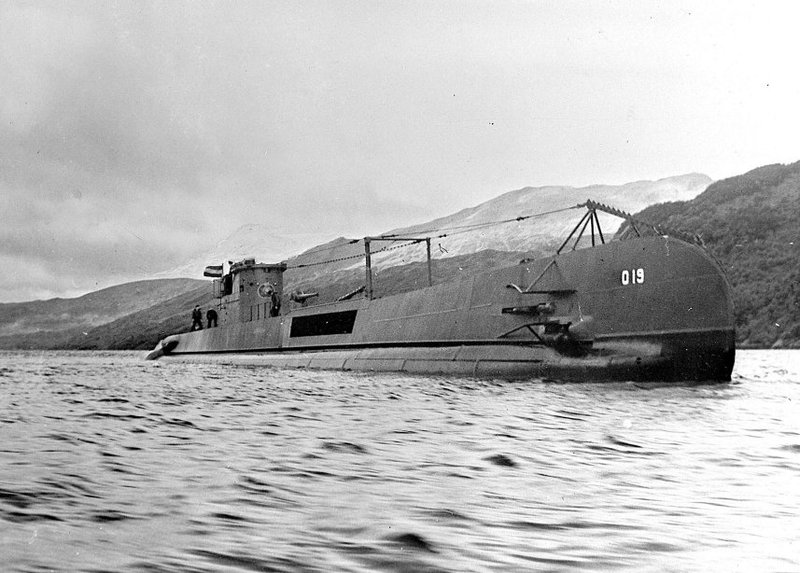
HNLMS O19 in Holy Loch
O19 class Submersibles (1938)

These two large submarines, just like the O16 of 1936, not coastal in spite of their denomination but oceanic ones, affected in the East Indies. In addition, they were the first Dutch mine-laying submersibles. They were very similar to the Orzel and Zep Poles built by the same shipyards, using the patented French Norman-Fenaux system with vertical tubes (20). In particular, they inaugurated a new system for hunting exhaust gases in periscopic diving, which the Germans recovered and perfected under the name of Snorchel. These large, fast-moving submersibles also used a double moving bench of torpedo tubes, four others at the bow and two at the stern. They were both sent to the Far East, the O20 being sunk by the destroyer Uranami on December 20, 1941, and the O19 ran aground in August 1945 in the China Sea after a busy career.
Specifications
Displacement & Dimensions 9981t. surface, 1536t Diving 81 x 7.50 x 4 m
Propulsion 2 propellers, 2 diesels-electric MAN, 5200/1000 cv. and 19.25 / 9 knots surf./dive ..
Crew 55
Armament 8 TLT 530 mm, 1 x 88 mm, 2 x 40 mm AA, 40 mines.
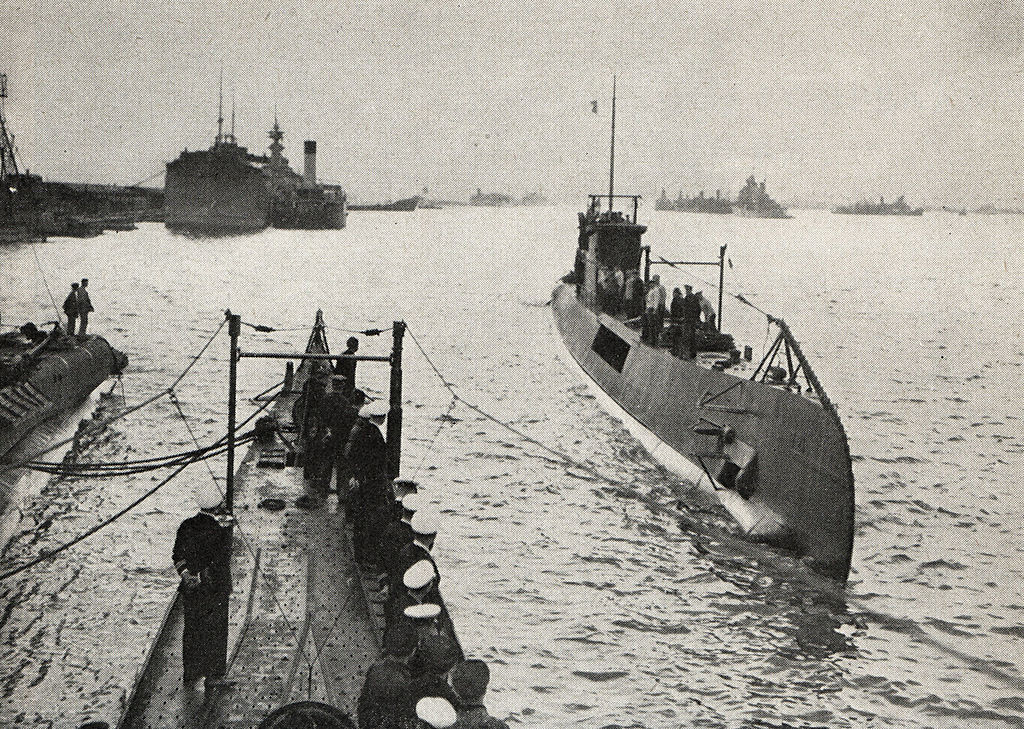
O21 at Gibraltar
Class O21 Submersibles (1939)

Literally modeled on the very successful O19, the O21 were the last Dutch submarines before the Cold War. They did not have the vertical tubes of mines, but the rest was identical, except for their slightly smaller dimensions. They were diving at 100 meters and had a range of 7,500 nautical miles at 10 knots. The class included 7 units as a result of the mobilization, but only 4 fureht completed in time, and fled to Britain to avoid capture. The O25, 26 and 27 will be integrated into the Kriegsmarine as UD3, 4 and 5 in 1941. They were scuttled in 1944-45. They were rearmed to the Kriegsmarine standard, with two 20mm cannons and Type IX U-Bootes kiosks. For their part, the first three re-visited with the RN until 1945, except the O22, sunk by the German minesweeper M144 assisted by a patrol boat off Lindense (Norway).
Specifications
Displacement & Dimensions 934t. surface, 1350t Diving 78 x 6.50 x 3.80 m
Propulsion 2 propellers, 2 diesels-electric MAN, 5200/1000 hp. and 19.5/9 knots surf./dive ..
Crew 55
Armament 8 x 533 mm TT, 1 x 88 mm, 2 x 40 mm AA, 1 x 12.7 mm MG AA
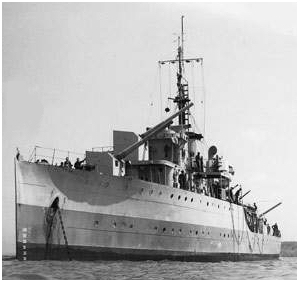
Flores class Gunboats (1925)
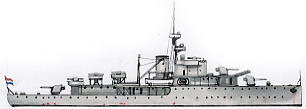
Both of these units were designed to provide harbor defense and reconnaissance pickets, with a non-catapult seaplane. The Flores, launched in 1925 was sent to France and managed to reach Britain in May 1940. It later served in the Mediterranean, receiving reinforcement 2 guns 40 and 2 20 mm AA. The Soemba, also launched in 1925, was in service in Soerabaya. In 1942, to avoid a useless sacrifice, he returned to order in the metropolis, gaining Great Britain. He received 6 guns of 20 mm AA and served in the Atlantic as escort. Both will be withdrawn from service in 1970 after having served as a harbor barge for a long time.
Specifications
Displacement & Dimensions 1457t, 1860t FL 75 x 11.50 x 3.58 m
Propulsion 2 propellers, 2 MTE, 4 Yarrow boilers, 2,000 hp. and 15 nodes max.
Crew 132
Armament 3 x 150 mm, 1 x 75 mm, 4 x 12.7 mm MG AA
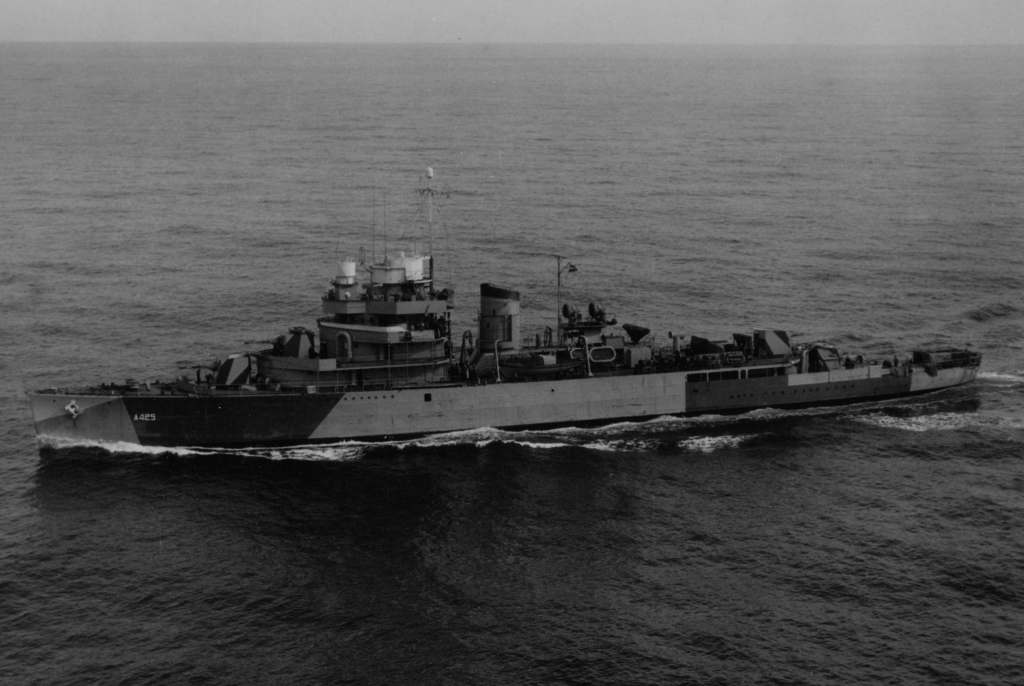
Van Kingsbergan 1944
Van Kingsbergan Sloop (1939)

No doubt the most powerful gunboat of his time, the Van Kingsbergan was as much a “coastguard” as a training ship. As a result, he had advanced shooting facilities and systems. Freshly entered into service, he managed to flee to UK in May 1940, and served mainly for escort and patrol missions. In 1942, he received, radar, asdic, and 6 guns of 20 mm AA in reinforcement. In 1951 he became a frigate, and in 1955 a ship-depot, before being retired from service in 1959.
Displacement & Dimensions 1760t, 2350t FL 103.20 x 11.58 x 3.12 m
Propulsion 2 propellers, 2 Werkspoor turbines, 2 Yarrow boilers, 16,000 hp. and 25.5 knots max.
Crew 190
Armament 4 x 120 mm, 4 x 40 mm AA.
Specifications
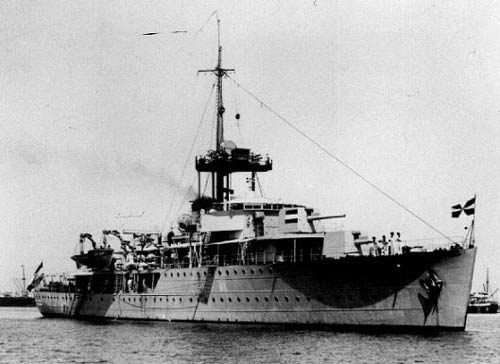
Johann Maurits Van Nassau Gunboat (1932)

The Van Nassau was defined in 1930 as an expanded Flores-type vessel to accommodate a better DCA. In April 1940, he was posted to France when he was sunk by a German air raid at Callanstoog. Like the Flores, he wore a 25 mm partial armor.
Specifications
Displacement & Dimensions 1520t, 1795t PC_79 x 11.50 x 3.73 m
Propulsion 2 propellers, 2 MTE, 4 Yarrow boilers, 2,100 hp. and 15 nodes max.
Armour 25 mm
Crew 124
Armament 3 x 150 mm, 2 x 40 mm AA, 4 x 12.7 mm AA MGs.
Minelayer Rigel (1931)
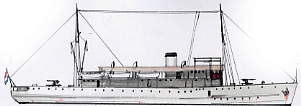
As one of the major minesweepers in the East Indian fleet, the Rigel was also the Governor’s Yacht in peacetime. Very slow, and modestly armed with field guns from the Great War, he was scuttled three years after his mobilization to block the entrance to the Tadjong Priok base. The Japanese refueled him in March 1944 but did not repair him and he returned to the Dutch in 1945. He became 5 years later the Dewakambar Indonesian flag, one of the first ships of these former Batavian colonies became independent.
Specifications
Displacement & Dimensions 1631t, 1952t PC_74 x 11 x 3 m
Propulsion 2 propellers, 1 MTE, 1400 hp. and 12.5 knots max.
Crew 63
Armament 2 x 76 mm, 2 x 12.7 mm AA MG, 150 mines.
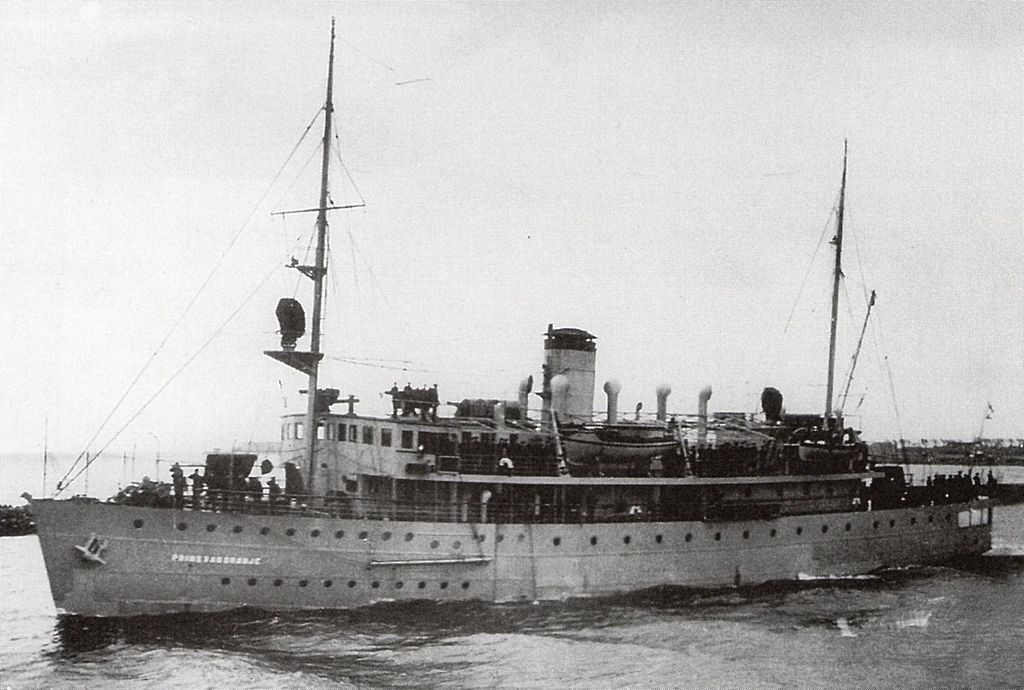
Van Oranje class minelayers (1931)
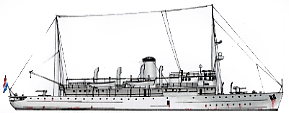
Gouden Leeuw Jan 1942
These two minesweepers, the Prinz van Oranje and the Gouden Leeuw, were built for the service of the eastern indies. They were specifically designed as mine layers, with a very high load capacity. The first was sunk during an unequal battle against Japanese destroyers on January 12, 1942, and the second sank in the harbor of Soerabaya on March 7, 1942.
Specifications
Displacement & Dimensions 1291t, 1450t PC_70 x 11 x 3.3m
Propulsion 2 propellers, 1 MTE, 1750 hp. and 15 nodes max.
Crew 121
Armament 2 x 76 mm, 2 x 40 mm, 2 x 12.7 mm AA MG, 150 mines.
Willem Van de Zaan class minelayers (1938)
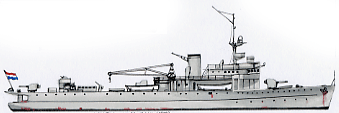
This modern and powerful building was designed for the city, and served there when the German invasion of May 1940 forced him to flee to Great Britain. He spent the rest of the war on the side of the Royal Navy, operating in the Atlantic and North Sea. He received a supplement of AAA in 1942 and served until the 60s.
Specifications
Displacement & Dimensions 1267t, 1450t PC_75,20 x 11,20 x 3,3 m
Propulsion 2 propellers, 1 MTE, 2 Yarrow boilers, 2300 hp. and 15.5 knots max.
Crew 120
Armament 2 x 120 mm, 4 x 40 mm, 4 x 12.7 mm AA MGs, 92 mines.
Jan Van Amstel class minesweepers (1936)

These light ships were 8 under construction in 1935. On this set, the Willem van Ejwick jumped on a mine on September 8, 1939 in Terschelling and a second identical unit was immediately started, launched in October 1940 but completed after capture by the Germans. (M553), and jumped on a mine in 1944. The Abraham van der Hulst and the Pieter Florisz scuttled together in May 1940, but were bailed out, repaired and returned to service under the name M552 and 551 by the Germans. The others were present in the Dutch East Indies, where the Van Amstel was sunk by Japanese destroyers on March 8, 1942, the Pieter de Bitter was scuttled at Soerabaya on March 6, 1942, the Abraham Crijnsen Eland Dubois at Gili Genteng. Jan Van Gelder survived the war.
Specifications
Displacement & Dimensions 450t, 585t PC_56.70 x 7.80 x 2m
Propulsion 2 propellers, 2 MTE, 2 Yarrow boilers, 1690 hp. and 15 nodes max.
Crew 46
Armament 1 x75 mm, 4 x 12.7 mm AA MG.
Sources
https://www.fr.naval-encyclopedia.com/2e-guerre-mondiale/pages/divers/hollande39/pages/marine_hollandaise.html
Conway’s all the word’s fighting ships 1860-1905, 1906-1921, 1921-1947
https://en.wikipedia.org/wiki/Category:World_War_II_naval_ships_of_the_Netherlands
https://en.wikipedia.org/wiki/Royal_Netherlands_Navy
A Photo of Cruiser De Ruyter – Ballarat Collection
https://ahoy.tk-jk.net/Letters/DutchshipsdeRuyterandJava.html
Right side of De Ruyter, camouflaged (TheBlueprints)

 Latest Facebook Entry -
Latest Facebook Entry -  X(Tweeter) Naval Encyclopedia's deck archive
X(Tweeter) Naval Encyclopedia's deck archive Instagram (@navalencyc)
Instagram (@navalencyc)





 French Navy
French Navy Royal Navy
Royal Navy Russian Navy
Russian Navy Armada Espanola
Armada Espanola Austrian Navy
Austrian Navy K.u.K. Kriegsmarine
K.u.K. Kriegsmarine Dansk Marine
Dansk Marine Nautiko Hellenon
Nautiko Hellenon Koninklije Marine 1870
Koninklije Marine 1870 Marinha do Brasil
Marinha do Brasil Osmanlı Donanması
Osmanlı Donanması Marina Do Peru
Marina Do Peru Marinha do Portugal
Marinha do Portugal Regia Marina 1870
Regia Marina 1870 Nihhon Kaigun 1870
Nihhon Kaigun 1870 Preußische Marine 1870
Preußische Marine 1870 Russkiy Flot 1870
Russkiy Flot 1870 Svenska marinen
Svenska marinen Søværnet
Søværnet Union Navy
Union Navy Confederate Navy
Confederate Navy Armada de Argentina
Armada de Argentina Imperial Chinese Navy
Imperial Chinese Navy Marinha do Portugal
Marinha do Portugal Mexico
Mexico Kaiserliche Marine
Kaiserliche Marine 1898 US Navy
1898 US Navy Sovietskiy Flot
Sovietskiy Flot Royal Canadian Navy
Royal Canadian Navy Royal Australian Navy
Royal Australian Navy RNZN Fleet
RNZN Fleet Chinese Navy 1937
Chinese Navy 1937 Kriegsmarine
Kriegsmarine Chilean Navy
Chilean Navy Danish Navy
Danish Navy Finnish Navy
Finnish Navy Hellenic Navy
Hellenic Navy Polish Navy
Polish Navy Romanian Navy
Romanian Navy Turkish Navy
Turkish Navy Royal Yugoslav Navy
Royal Yugoslav Navy Royal Thai Navy
Royal Thai Navy Minor Navies
Minor Navies Albania
Albania Austria
Austria Belgium
Belgium Columbia
Columbia Costa Rica
Costa Rica Cuba
Cuba Czechoslovakia
Czechoslovakia Dominican Republic
Dominican Republic Haiti
Haiti Hungary
Hungary Honduras
Honduras Estonia
Estonia Iceland
Iceland Eire
Eire Equador
Equador Iran
Iran Iraq
Iraq Latvia
Latvia Liberia
Liberia Lithuania
Lithuania Mandchukuo
Mandchukuo Morocco
Morocco Nicaragua
Nicaragua Persia
Persia San Salvador
San Salvador Sarawak
Sarawak Uruguay
Uruguay Venezuela
Venezuela Zanzibar
Zanzibar Warsaw Pact Navies
Warsaw Pact Navies Bulgaria
Bulgaria Hungary
Hungary

 Bundesmarine
Bundesmarine Dutch Navy
Dutch Navy Hellenic Navy
Hellenic Navy Marina Militare
Marina Militare Yugoslav Navy
Yugoslav Navy Chinese Navy
Chinese Navy Indian Navy
Indian Navy Indonesian Navy
Indonesian Navy JMSDF
JMSDF North Korean Navy
North Korean Navy Pakistani Navy
Pakistani Navy Philippines Navy
Philippines Navy ROKN
ROKN Rep. of Singapore Navy
Rep. of Singapore Navy Taiwanese Navy
Taiwanese Navy IDF Navy
IDF Navy Saudi Navy
Saudi Navy Royal New Zealand Navy
Royal New Zealand Navy Egyptian Navy
Egyptian Navy South African Navy
South African Navy






























 Ukrainian Navy
Ukrainian Navy dbodesign
dbodesign